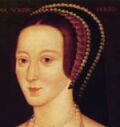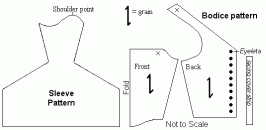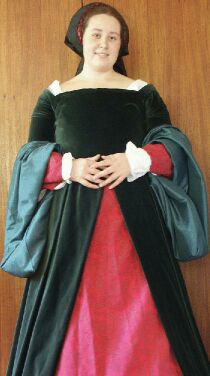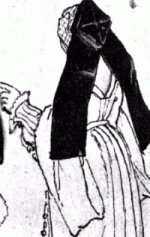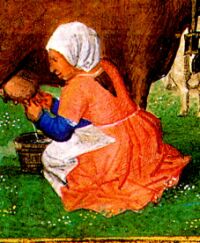
Cranach,
1537, Hercules and Omphale (Detail) (Image from La Couturière
Parisienne)

Unknown
Artist, c.1560, Portrait of Mary Fitzalan, Duchess of
Norfolk

Holbein,
c.1535, miniature of Mrs Pemberton (Detail)

Holbein c.1536 Portrait
of Jane Seymour (Detail)
|
Gown
- I've come to
the conclusion that the way the shoulder straps
are constructed is not period. My next dress wil
feature more normal shoulder straps similar to
those in the pattern to the right from Juan de
Alcega's pattern book.
- The next Tudor
gown I make will feature the gown's sleeves cut
in 2 pieces one for the fitted section and one
for the bell shaped section. Although there is no
evidence from English sources for how these
sleeves are constructed the German picture to the
left shows a woman wearing a similar shaped
sleeves which aren't pinned up.
- At some point
in the future I would like to replace the lining
for the sleeves with a brocade. When I made this
gown I spent a long time searching for pictures
of velvet gowns in order to find out what would
be used in place of the fur/velvet more commonly
seen. The only velvet dress I could find was Jane
Seymour’s (above) and finding that sort of
net like fabric was not possible. Therefore I
decided to use a plain imitation silk. After I
had completed the gown I found a picture
featuring brocade sleeve lining and a plain
coloured fabric for the gown (see detail right).
I believe the body of the gown is most likely
velvet, as, with the exception of Jane Seymour's
portrait above, (where there is sufficient detail
to see that it is made of velvet) this style of
dress is depicted with the sleeves lined with
fur, velvet or the same fabric as the body of the
gown, it is, however, impossible to see enough
detail in this picture to know exactly. It’s also
interesting to note that except for the train and
the colour of the French hood, my gown has turned
out a closer imitation of this gown than the Jane
Seymour gown I was aiming for.
Update, 31 March 2005: I have found another
picture showing a velvet gown with brocade lined
sleeves (see portrait of Mary Fitzalan, Left). In
this portrait it is far more clear that the main
fabric of the gown is actually velvet
- In my next
Tudor style gown I would like to experiment with
a pin on stomacher and front lacing, the
portraits of Mrs Pemberton and Jane Seymour
(left) show the pins down the side of the bodice.
The sketch of Cecily Heron (right) shows this
style of gown with the stomacher removed.
|

Pattern
for a woman's low cut bodice and kirtle. From Juan de Alcega's
pattern book 1589 (thanks to Deb for the image)
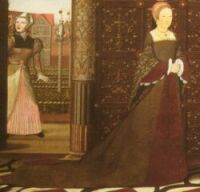
Unknown
Artist, c.1545 Whitehall Mural
of Henry VIII's family (detail showing Princess Mary)
(click on the picture for a larger version or here for the full mural)

Holbein,
c.1527, Sketch of Cecily Heron
|
